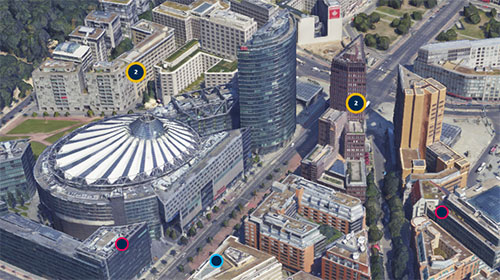Immersive technologies
3D information brought to life
Immersive technologies, often referred to as XR, offer an immersive experience that blurs the boundaries between the physical and digital worlds. In both private and professional contexts, they have become significantly more relevant in recent years and will have an even greater impact on various areas of society in the coming years, as well as influencing our understanding of interaction and reality.
They enable business innovations, transform industrial processes, expand cultural experiences and have an impact in areas of education and healthcare and much more. The global AR market size alone is expected to grow from approximately $6.1 billion in 2021 to approximately $97.8 by 2028. That would correspond to an annual growth rate of 48.6 percent. Virtual Reality, Augmented Reality and Mixed Reality are rapidly developing into an integrated standard as interactive technologies.
The advantages are obvious:
- Efficient & sustainable process design
- Realistic simulation
- Immersive experience
- Breaking down complexity through visualization
Interactive 3D visualizations or applications that can be experienced make abstract expert knowledge accessible and interactive, supporting understanding and thus communication.
Location advantages of Berlin
- Talent: around 200,000 students make Berlin the city with the most enrolled students in Germany
- Strong startup scene
- International hub for trusted AI
- Impulse for creative industries (esp. film, media, music, fashion, games)
- Research: A large number of excellent and diverse research institutes in Berlin are working successfully on further development in terms of content and technology
Scientific institutions
- Hochschule für Technik und Wirtschaft (HTW)
- Fraunhofer Institutes (FOKUS, HHI, IPK)
- Charité Universitätsmedizin Berlin
- BHT Berliner Hochschule für Technik
- Max-Planck-Gesellschaft
- Technische Universität Berlin
- Universität der Künste
- Mediadesign University
- SAE Institute Berlin
- Fachhochschule des Mittelstands (FHM)
- Macromedia University
Immersive tech-scene
Talent: around 200,000 students make Berlin the city with the most enrolled students in Germany As a leading media and creative location in Germany, the regional strength of narration and content production has developed due to its proximity to the Babelsberg film studios, among other things. The areas of games, entertainment, education - in the sense of vocational training and further education, as well as knowledge transfer in the cultural sphere - and tourism are the areas of application with the highest sales in the region.
The XR scene in Berlin is made up of stakeholders from the cultural and creative scene as well as the digital economy.
As a cross-sectional technology, the application potential extends across a large number of sectors. The healthcare industry in Berlin in particular has a strong interest in applications such as simulating surgical procedures or treating patients with specific phobic disorders.
New, innovative and audiovisual XR applications are also constantly being developed in Berlin’s typical fashion and music scene - from virtual fittings and NFT Metaverse art exhibitions to immersive classical concert experiences.
Outlook
The big bang was expected, but instead a quiet revolution happened and is still ongoing. Immersive technologies have already reached industrial users as well as the creative industries. Among other things, this will continue to be driven by the constant further development of AI, 5G and IoT, which developed a new dynamic in the scene in 2023 alone.
A little further in the future, but also worth an excited look, is the topic of quantum computing and the BQA - Berlin Quantum Alliance, founded in 2023, with the innovation hub Leap. The exchange between the communities has already been initiated and has uncovered exciting topics.
Metaverse, virtual worlds, CitiVerse, ... - there are many names for the concept. There is a broad consensus that XR will play a very relevant role as an enabler alongside Blockchain. Berlin’s internationally popular creative industry is an impressive driver in bringing the topic into application. On the technical side, the Web3 infrastructure of the Metaverse is intended to move the user away from an observing role to an acting role and thus requires an immersion of the user, which can be made possible by an XR interface. Berlin’s status as one of the global hotspots for blockchain and Web3 is helpful here.
An exciting metaverse momentum to set an XR footprint.


